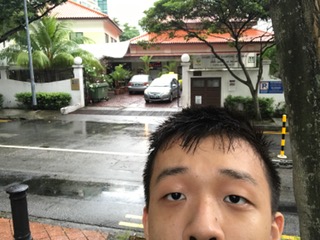Made in Singapore
I chose this activity for the AEC Singapore Shares CA1 because I find it interesting that Singapore has made their own unique products and businesses. There are surprisingly many things that are made in Singapore.
Firstly, there is “Charles & Keith”. “Charles & Keith” was founded in 1996 by brothers Charles and Keith Wong. The store originally sold women’s shoes made in China and Malaysia but started to design their own shoes with feedback from customers and have now spread out to other parts of the world such as Indonesia and Phillipines.

Another invention made in Singapore is “Carousell”. It was founded by co-founders Quek Siu Rui, Lucas Ngoo, and Marcus Tan. “Carousell” is an online marketplace for buying and selling new or secondhand goods and have now expanded to other countries such as Malaysia, Indonesia and Taiwan.

Lastly, another well renown Singapore brand is “BreadTalk”. “BreadTalk” is a bakery brand founded in Singapore. It has now became an award-winning F&B Group and has expanded across Asia in countries namely, Malaysia, Hong Kong and Thailand.
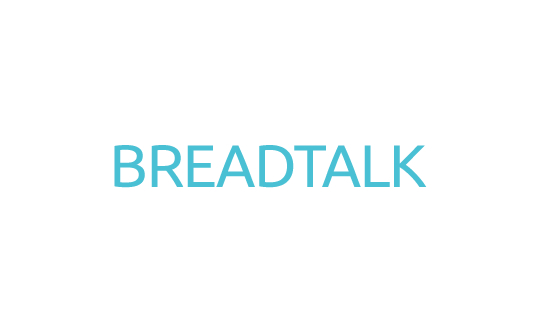
If I was an inventor, I would create something that helps to make things more convenient for human life. I think these creators mentioned above are really inspiring as they are actually still normal humans just like us. It means that everyone is capable of changing the world for the better. I am capable of changing the world for the better. From this activity, I learned that we should not just follow the “correct” ways of doing things, we can find our own way and maybe we find out something better. I can apply this to my daily life by trying to see things from a different perspective and find a better way of doing things.
https://en.wikipedia.org/wiki/Charles_%26_Keith
https://en.wikipedia.org/wiki/Carousell_(company)
https://en.wikipedia.org/wiki/BreadTalk
What/Where To Eat?
I chose this box because Singapore is known for the food and there are many food places in Singapore. It will not be hard to find a food place in Singapore when they are almost everywhere in Singapore.
I think the first place that I might bring them to is just a normal hawker center in Singapore. As I am eating with this diverse group with different preferences, local hawker centers are great because they have many stalls that sell different food including seafood, halal food and maybe eco-friendly organic food.

If the environment of the hawker centers is not to their liking, maybe the second place I might bring them to is a food court indoors. Singapore can be really warm, so if we want to eat in some place with air-conditioning, a food court indoors will be perfect. Examples of food courts in Singapore are Kopitiam or Koufu. They sell a various of different food from around the world which is good if we are eating with a diverse group. The have seafood, halal food or even eco-friendly organic food.


If those group of people do not like to eat these kinds of food and may want to eat at restaurants or social enterprise eateries, they might want to try Eighteen Chefs. Eighteen Chefs was founded by an ex-offender Benny Se Teo. This place is halal and they sell seafood and maybe some of those eco-friendly organic food. Also, this place is not as cheap as the others but it is still affordable.

From this activity I learned that many people have different preferences for food and we have to respect them. We should not judge people based on their preferences. So, in the future, I will not look up to those people who eat at fancy restaurants and continue living my life eating at cheaper food places.
https://en.wikipedia.org/wiki/Hawker_centre
http://www.eighteenchefs.com/v2/
Unusual Occupations
I chose this box because it sounds interesting and I would also like to find out more about the jobs in Singapore. “Unusual” can mean different things to different people. According to Oxford Dictionaries, unusual is something not habitually or commonly occurring or done. And that is what it also means to me.
The first occupation I found interesting and unusual is a professional ad clicker. All you have to do is spam the left mouse button and earn free money. You can earn around 18 to 25 cents per click. If you click about 10 times a second, you can earn like $1.80 to $2.50 every second.

The second occupation I found unusual is a queuer. Yup, it is as it sounds, you just queue in line for people. This can be useful especially in sales or to be the first in line for the new iPhone release. You can be paid up to $50 per hour for queuing for people.

Lastly, another unusual occupation I found is a professional sleeper. Yes, you can get paid by sleeping. Oh wow, so useful to society. Surprisingly, they are quite well paid at about $420000 a year. This job basically is having you to be test subjects to learn the sleeping habits of people to better develop solutions for insomnia.

From this activity I learned that we are all allowed to do what we want. I learned that we have to chase our dreams and pursue them in spite of what other people might think or say. We can all be professional sleepers if we so wish. I want to be a physicist in the future and I will not let other people stop me from chasing my dreams (that is provided there even is such a job in Singapore). Otherwise, I have to resort to some random office job and live the boring 9-5 life doing something I might not like.
https://en.oxforddictionaries.com/definition/unusual
10 Strangest Jobs You Can Get In Singapore To Escape The 9-5 Grind
Society & Co.
I chose this box because I want to know more about the different companies that not just think about making money but also the other things that they do that help out in society.
The first example of a good Corporate Social Responsibility company is StarBucks. Since Starbucks Coffee started in 1971, the company has focused on acting responsibly and ethically. Starbucks has been around for more than four decades, and from the very beginning it has worked hard to operate in an ethical manner. Starbucks ranked as Fortune Magazine’s fifth most socially responsible company in 2012. The company looks for better ways to develop sustainable production of its coffee. It has set in place some guidelines it calls C.A.F.E Practices, ensuring environmental leadership, economic accountability, and product quality. Starbucks also supports Ethos Water, which provides clean water to more than a billion people who do not have access. To date, Ethos Water has committed to grants totaling more than $6.2 million.

The next example of a social enterprise is Ben & Jerry’s. Ben & Jerry ‘s founders Ben Cohen and Jerry Greenfield have infused the company with the notions of giving back in every way possible, as well as “linked prosperity” between the company, its employees and the community. They started the Ben & Jerry ‘s Foundation, were founding members of the Business for Social Responsibility organization and set an extraordinary rate of giving to charitable organizations in the corporate world, donating a full 7.5% of pretax profits. In their own words, they “strive to show a deep respect for human beings inside and outside our company and for the communities in which they live.” Unilever bought Ben & Jerry ‘s in 2000 and continues to support the foundation; it donated $2 million in 2009.

Lastly, Microsoft is also a company which have good Corporate Social Responsibility. Microsoft is another major company that takes great effort in giving back. The company was even named the best at Corporate Social Responsibility by the Reputation Institute. One way Microsoft is helping out is through its annual Employee Giving Campaign, where employees attend fundraising events for nonprofit organizations. The campaign has been held every year since 1983 and has raised more than $1 billion in contributions to more than 31,000 organizations.
From this activity I learned that there are many companies that not only aim to make money but also serve a good cause to the society. So, in my daily life, I should not only think about the benefits to doing work but instead to think more about the journey and how I make an impact in others lives. I must take into consideration people’s feelings instead of just doing things the most logical and efficient way.
http://adage.com/article/cmo-strategy/10-companies-social-responsibility-core/143323/
Can I change?
Why I chose this box? I want to change for the better. There is a lot room for improvement in me. I need to learn to change my views about other people and learn to accept them. I want to change my heart to be able to put myself in their shoes and understand them from their perspective.
There may be some things in my life that I need to change. For example, I may be thinking that lazing around binge watching videos on YouTube in my free time is perfectly fine. However, to other people this may not be fine, they say it is a waste of time and that you are not doing anything productive. That is why I need to change my life.
So, over the period of next time, I will adopt this six stage change cycle thing. Usually on weekends, I spend around a quarter to half a day watching videos. And on weekdays, I spend around five to six hours. When I have homework, I would do my homework first before watching videos. My plan for this activity is to try to reduce the amount of time that I spent watching videos. So on day one, I spent six hours watching. On the second day, I managed to reduce my spending time to five hours. Sometimes, I have nothing to do and I get bored then I got back to the old habits. After a week or so, I managed to cut my watching hours to three hours a day. If I have extra free time, I would be exercising or eating or sleeping. In the end, I feel like limiting myself to two hours of watching videos is enough and that I do not need to completely terminate it.
From this activity, I learned the value of discipline and self-control. I learned that in anything in life, we have to be disciplined and have self-control to be able succeed in doing what you want in life. I can apply what I learned by practicing discipline and focus on doing one thing before starting another thing. I think that it is important to focus on your goals in life and strive for it.
https://psychcentral.com/lib/stages-of-change/?all=1
Heritage Trail
So for my heritage trail, I decided to go for the Singapore River Walk. Why I went to the Singapore River Walk? I went there because I want to see how Singapore was like before it was modernized and learn about how the people in the past traded.
So the first place I visited is Collyer Quay (Clifford Pier).
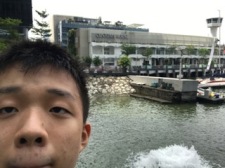
Built in 1933, Clifford Pier was a landing point for immigrants and other sea passengers. A red oil lamp used to hang from the pier as a guide to seafarers, earning the pier the name Red Lamp Pier. The pier was later used as a terminal for tourists and day trippers who boarded small boats and ferries heading for the Southern Islands. During the annual pilgrimage season to Kusu Island, regular ferries departed from Clifford Pier to the island.
https://en.wikipedia.org/wiki/Clifford_Pier
Next, I went to the Collyer Quay (Customs House).
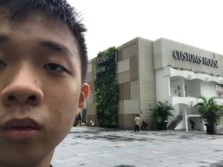
The Customs department was founded when Singapore was the British Empire’s Straits Settlement and later Crown Colony. Established in 1910 under the name Government Monopolies Department, Customs is one of the oldest tax-collecting organisations in modern Singapore to increase the country’s state coffers to help fund national programmes. Revenue collection began in December 1909 when the first import duty was imposed on hard liquors. In 1916, the tariff was extended to include tobacco and cigarettes. The collection of duty on petroleum was introduced in 1934. Motor vehicles are also subject to tax and excise duties. Effective 1 January 2012, compressed natural gas (CNG) for motor vehicles is subject to tax and excise duty.
https://en.wikipedia.org/wiki/Singapore_Customs
After that, I went to the Cavenagh Bridge.
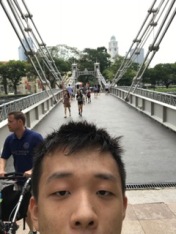
Originally known as the Edinburgh Bridge to commemorate the visit of the Duke of Edinburgh, its name was changed to Cavenagh Bridge in honour of Major General William Orfeur Cavenagh, the last India-appointed Governor of the Straits Settlements, who governed from 1859 to 1867. The coat of arms of the Cavenagh family can still be seen atop the signage at both ends of the bridge.
Cavenagh Bridge linked the Civic District on the northern bank to the Commercial District on the southern bank of the Singapore River. Before Cavenagh Bridge was constructed, people could only get to the two districts via a detour over Elgin Bridge or by paying 1 duit for a boat ride across the river.
This bridge has elaborate suspension struts in comparison with most other suspension bridges, and is the third bridge to be built in Singapore. It was constructed in 1869 to allay the inconvenience of crossing the Singapore River by boat. It was originally designed as a drawbridge but on its completion was found to be suitable only as a fixed structure. Numerous steel rivets were used in its construction, which employed steel casting methods commonly used during that era.
https://en.wikipedia.org/wiki/Cavenagh_Bridge
Then, I went to Raffles Place.
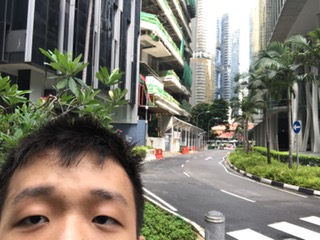
A hill originally stood at Raffles Place, the soil of which was then used to reclaim the southern bank of the Singapore River to form Boat Quay. Known as Commercial Square then, Raffles Place was no more than a quiet green when it was first developed from 1823 to 1824. As the economy of Singapore grew, two- and four-storey buildings sprang up around the square, housing mercantile offices, banks and tradingcompanies.
In 1858, Commercial Square was renamed Raffles Place. The sea came right up to the buildings on the south side of the square then, many of which were godowns with jetties that allowed cargo to be loaded and unloaded directly from boats. From 1857 to 1865, the land by the south side was reclaimed for commercial use. This new land became Collyer Quay. With a larger area designated for commerce, more businesses flocked to Raffles Quay, most notably retail stores and banks.
https://en.wikipedia.org/wiki/Raffles_Place
Now, I managed to go to Boat Quay.
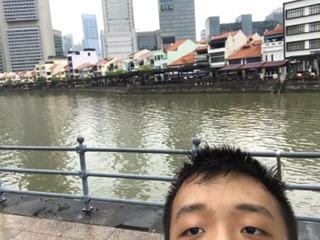
Boat Quay is a historical quay in Singapore which is situated upstream from the mouth of the Singapore River on its southern bank.
It was the busiest part of the old Port of Singapore, handling three-quarters of all shipping business during the 1860s. Because the south of the river here resembles the belly of a carp, which according to Chinese belief is where wealth and prosperity lay, many shophouses were built, crowded into the area.
Though serving aquatic trade is no longer Boat Quay’s primary role, the shophouses on it have been carefully conserved and now house various bars, pubs and restaurants. Therefore, Boat Quay’s social-economic role in the city has shifted away from that of trade and maritime commerce, and now leans towards more of a role accommodated for tourism and aesthetics for the commercial zone of which encloses the Singapore River. It is the soft front to the composolitian banking and financial sectors lying immediately behind it.
https://en.wikipedia.org/wiki/Boat_Quay
Okay, so after that, I went to the Elgin Bridge which is right beside Boat Quay.
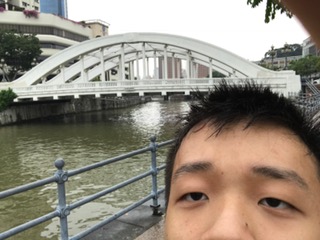
Elgin Bridge is a vehicular bridge across the Singapore River, linking the Downtown Core to the Singapore River Planning Area located within Singapore’s Central Area.
The bridge was named after Lord Elgin, Governor-General of India (21 March 1862 – 20 November 1863) in 1862 when an iron bridge was built across the river, replacing an older wooden bridge. The current bridge was built in 1929. As this was the first bridge across the river, the two roads leading to it were named North Bridge Road and South Bridge Road accordingly.
https://en.wikipedia.org/wiki/Elgin_Bridge_(Singapore)
Then, I went to the Coleman Bridge.
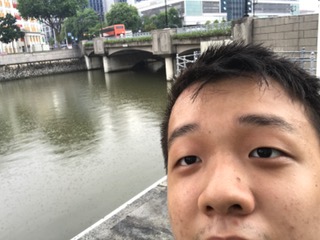
In 1840, a brick bridge joining Old Bridge Road and Hill Street over the Singapore River was constructed and called Coleman Bridge. The bridge had nine arches, and was designed by and named after George Drumgoole Coleman (1795–1844), an Irish architect and Singapore’s first architect. It was referred to as the New Bridge, lending its name to the road on its southern end — New Bridge Road.
In 1865, the brick bridge was replaced by one made of timber but was not well constructed. It cost about Straits $10,000 and was built by the government. In 1886, an iron bridge was built to replace the wooden one. This iron bridge was considered one of the most attractive spanning the Singapore River. It stood for about a century, but was unable to cope with the increasingly heavy traffic flow between New Bridge Road and Hill Street.
The iron bridge was finally demolished in 1986 and replaced with the present concrete bridge. However, several features of the iron bridge such as the decorative lamp posts and iron railings were incorporated into the current structure, in recognition of its historical significance.
https://en.wikipedia.org/wiki/Coleman_Bridge,_Singapore
After Coleman Bridge, I went to Clarke Quay.
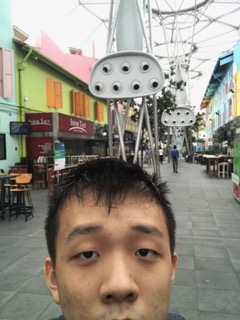
Clarke Quay was named after Sir Andrew Clarke, Singapore’s second Governor and Governor of the Straits Settlements from 1873 to 1875, who played a key role in positioning Singapore as the main port for the Malay states of Perak, Selangor and Sungei Ujong.
Clarke Quay is also the name of a road along the quay, part of which has since been converted into a pedestrian mall. Clarke Street, located next to Clarke Quay, was officially named in 1896, and was originally two streets known simply as East Street and West Street in north Kampong Malacca. Similar to Clarke Quay, Clarke Street has since been converted into a pedestrian mall.
https://en.wikipedia.org/wiki/Clarke_Quay
After Clarke Quay is the Read Bridge.
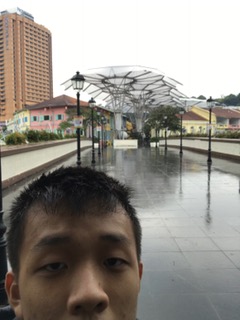
Read Bridge was named after William Henry Macleod Read, who was a prominent resident in Singapore between 1841 and 1887 and Consul for the Netherlands between 1857 and 1885. The bridge’s construction took place in 1881 and was completed in 1889. The bridge was opened by then governor Clementi Smith in 1889, Read laid the first cylinder in 1887, before he left the colony. The locals called the bridge Malacca Bridge, given its proximity to Kampong Malacca at Merchant Road. The Hokkiens refer the bridge as kam kong ma lah kah kio (Kampong Malacca Bridge).
https://en.wikipedia.org/wiki/Read_Bridge
Next, I saw the Former Thong Chai Medical Institution.
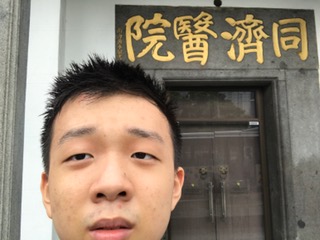
The Old Thong Chai Medical Institution is a historic building in Singapore, and is located at Eu Tong Sen Street in the Singapore River Planning Area, within the Central Area, Singapore’s central business district.
The building was constructed in 1892, and housed one of the best known Chinese charity medical centres in Singapore. Traditional Chinese doctors or sinsehs used to dispense free treatment and medicine to patients of all races in Singapore. Today, it is used as a commercial building for the Singapore office for Forever Living Products.
https://en.wikipedia.org/wiki/Old_Thong_Chai_Medical_Institution
Then, I went to the Masjid Omar Kampong Melaka
Masjid Omar Kampong Melaka is a mosque in Singapore, and is located at Keng Cheow Street in the Singapore River Planning Area, within the Central Area, Singapore’s central business district.
The first mosque to be built in Singapore, Masjid Omar Kampong Melaka was established in 1820, just a year after the British set up a trading post on the island. Since then, the mosque has been rebuilt twice; once in 1855 and again in 1981-1982. The mosque is owned by Majlis Ugama Islam Singapura.
https://en.wikipedia.org/wiki/Masjid_Omar_Kampong_Melaka
After that, I visited the Tan Si Chong Su Temple.
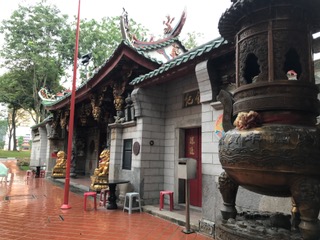
Tan Si Chong Su, or Ancestral Hall of the Tan Clan, is a Chinese temple in Singapore. It is located on Magazine Road in the Singapore River Planning Area within Singapore’s central business district. It was constructed between 1876 and 1878 as the ancestral temple for those with the same Tan surname, based on the premise that Chinese people with the same surname would share a common ancestry and therefore belong to the same clan.
The temple is also known as Po Chiak Keng meaning “palace for the protection of the innocent”, reflecting its earlier role as a place that provided help for those in disputes as well as new Chinese immigrants in Singapore.
https://en.wikipedia.org/wiki/Tan_Si_Chong_Su
Right next to the temple, there was a bridge called Clemenceau Bridge.
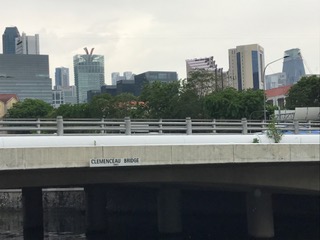
Clemenceau Bridge was built at the same time as Clemenceau Avenue. Both are named after Monsieur Georges Clemenceau, the Prime Minister of France who visited Singapore in 1920 and marked the foundation of Clemenceau Avenue. In the past, Clemenceau Avenue used to run from Havelock Road all the way to Newton Circus. With the construction of the CTE, the road is cut into half. The northern stretch, between Newton Circus and Cairnhill Circle, has been renamed Clemenceau Avenue North. The sourthern stretch starts from Penang Road and extends to Havelock Road. A segment of CTE now runs along the middle stretch of Clemenceau Avenue that was expunged. Prior to 1919, the road was known as Tank Road.
The last place I went is Ord Bridge.
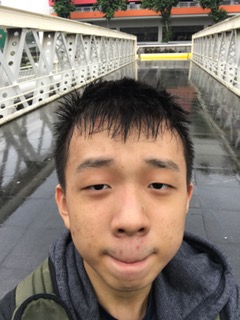
Ord Bridge is a pedestrian bridge in Singapore. It spans the Singapore River at Clarke Quay, located in the Singapore River Planning Area within the Central Area.
The Ord Bridge was built in 1886 to replace a demolished footbridge known as the ABC Bridge. The steel truss bridge was named after Colonel Sir Harry St. George Ord (1819–1885), the first British Governor of the Straits Settlements (1867–1873) after it was given the Crown Colony status.
The new name was also an abbreviation of its old name, Ordnance Bridge, which was a reference to the British ordnance depot along Magazine Road. It was also known as Toddy Bridge as there were toddy shops in nearby Pulau Saigon, an island on Singapore River which has since been reclaimed.
https://en.wikipedia.org/wiki/Ord_Bridge
Conclusion
So from this heritage trail, I feel that Singapore has really came a long way from being a third-world country to a first-world country. Singapore is still relatively young compared to other countries and is still much more advanced than other countries. It is truly amazing how Singapore has made such a big progress in 52 years. From a fishing port to a bustling city. The culture in the past is so different compared to now.
I think as a citizen, we need to understand our county’s history and culture. Why this place is built exactly the way it is? Why do people need to build that there? Why do people think that doing what they did was a good idea? I think there is always a deeper meaning behind these infrastructures.

